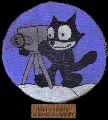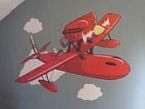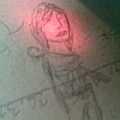obvert
Posts: 14050
Joined: 1/17/2011
From: PDX (and now) London, UK
Status: offline

|
quote:
ORIGINAL: tiemanj
Random guessing here... but with a time to alert in the 10 or so minutes range, is it possible that the 30ish k altitude ones are climbing to meet the sweepers at 42k (or above their max maneuver), but the 10ish k ones don't have the time (and thus meet while still in max maneuver territory)?
Here is a CR from one of the high layered CAP tests.
The initial sweep seems to be met at the set altitudes (no indication of scrambling fighters between --- and ---)
The two later intercepts both show the groups attempting to scramble to above the 31k band. I guess there is no sure fire method of knowing whether they make it.
I can do several things to isolate elements on this test though. (Lokasenna gave a great suggestion to isolate group's planes to see which band ends up fighting, and wining or losing, but if there are any more suggestions, keep em comin!)
1. I could change the Ki-84r to maneuver 27 at all bands to see if this changes the results.
2. I could change the Ki-84 to restrict high altitude to below 31k, or even to 20k, or to 10k, and see if those make a difference in outcomes.
3. I could change climb rates to 3,200, or even higher, to see if more planes make it up there and how that affects results.
--------------------------------------------------------------------------------
AFTER ACTION REPORTS FOR Aug 18, 42
--------------------------------------------------------------------------------
Morning Air attack on Lae , at 99,126
Weather in hex: Thunderstorms
Raid spotted at 27 NM, estimated altitude 43,000 feet.
Estimated time to target is 8 minutes
Japanese aircraft
Ki-84r Frank x 69
Allied aircraft
P-47D2 Thunderbolt x 24
Japanese aircraft losses
Ki-84r Frank: 4 destroyed
Allied aircraft losses
P-47D2 Thunderbolt: 5 destroyed
CAP engaged:
10th Sentai with Ki-84r Frank (0 airborne, 16 on standby, 0 scrambling)
7 plane(s) not yet engaged, 0 being recalled, 0 out of immediate contact.
Group patrol altitude is 26000
Time for all group planes to reach interception is 15 minutes
1000th Sentai with Ki-84r Frank (0 airborne, 16 on standby, 0 scrambling)
7 plane(s) not yet engaged, 0 being recalled, 0 out of immediate contact.
Group patrol altitude is 31000
Time for all group planes to reach interception is 28 minutes
100th Sentai with Ki-84r Frank (0 airborne, 16 on standby, 0 scrambling)
7 plane(s) not yet engaged, 0 being recalled, 0 out of immediate contact.
Group patrol altitude is 28000
Time for all group planes to reach interception is 27 minutes
--------------------------------------------------------------------------------
Morning Air attack on Lae , at 99,126
Weather in hex: Thunderstorms
Raid detected at 43 NM, estimated altitude 45,000 feet.
Estimated time to target is 12 minutes
Japanese aircraft
Ki-84r Frank x 48
Allied aircraft
P-47D2 Thunderbolt x 24
Japanese aircraft losses
Ki-84r Frank: 7 destroyed
Allied aircraft losses
P-47D2 Thunderbolt: 1 destroyed
Aircraft Attacking:
8 x P-47D2 Thunderbolt sweeping at 42000 feet
CAP engaged:
1000th Sentai with Ki-84r Frank (0 airborne, 0 on standby, 0 scrambling)
15 plane(s) not yet engaged, 7 being recalled, 0 out of immediate contact.
Group patrol altitude is 31000 , scrambling fighters between 27000 and 31498.
Time for all group planes to reach interception is 13 minutes
100th Sentai with Ki-84r Frank (0 airborne, 0 on standby, 0 scrambling)
9 plane(s) not yet engaged, 4 being recalled, 1 out of immediate contact.
Group patrol altitude is 28000 , scrambling fighters between 27000 and 31498.
Time for all group planes to reach interception is 31 minutes
10th Sentai with Ki-84r Frank (0 airborne, 0 on standby, 0 scrambling)
8 plane(s) not yet engaged, 4 being recalled, 0 out of immediate contact.
Group patrol altitude is 26000 , scrambling fighters between 28000 and 32000.
Time for all group planes to reach interception is 51 minutes
--------------------------------------------------------------------------------
Morning Air attack on Lae , at 99,126
Weather in hex: Thunderstorms
Raid detected at 68 NM, estimated altitude 46,000 feet.
Estimated time to target is 20 minutes
Japanese aircraft
Ki-84r Frank x 21
Allied aircraft
P-47D2 Thunderbolt x 6
Japanese aircraft losses
Ki-84r Frank: 2 destroyed
No Allied losses
Aircraft Attacking:
3 x P-47D2 Thunderbolt sweeping at 42000 feet
CAP engaged:
1000th Sentai with Ki-84r Frank (0 airborne, 0 on standby, 0 scrambling)
9 plane(s) not yet engaged, 0 being recalled, 0 out of immediate contact.
Group patrol altitude is 31000 , scrambling fighters between 27000 and 34450.
Time for all group planes to reach interception is 30 minutes
100th Sentai with Ki-84r Frank (2 airborne, 0 on standby, 0 scrambling)
2 plane(s) intercepting now.
6 plane(s) not yet engaged, 0 being recalled, 0 out of immediate contact.
Group patrol altitude is 28000 , scrambling fighters between 28000 and 32996.
Time for all group planes to reach interception is 39 minutes
10th Sentai with Ki-84r Frank (0 airborne, 0 on standby, 0 scrambling)
4 plane(s) not yet engaged, 0 being recalled, 0 out of immediate contact.
Group patrol altitude is 26000 , scrambling fighters between 27000 and 31000.
Time for all group planes to reach interception is 27 minutes
< Message edited by obvert -- 3/23/2016 6:21:06 PM >
_____________________________
"Success is the ability to go from one failure to another with no loss of enthusiasm." - Winston Churchill
|
 Printable Version
Printable Version























 New Messages
New Messages No New Messages
No New Messages Hot Topic w/ New Messages
Hot Topic w/ New Messages Hot Topic w/o New Messages
Hot Topic w/o New Messages Locked w/ New Messages
Locked w/ New Messages Locked w/o New Messages
Locked w/o New Messages Post New Thread
Post New Thread